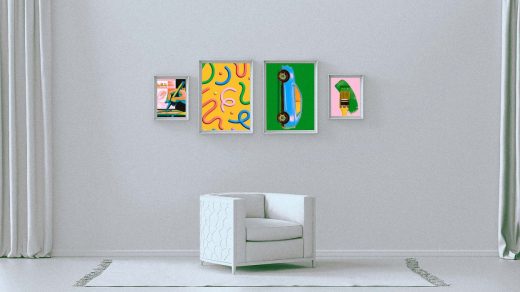These are the trends designers want to see disappear this year
Whether it’s Barbie Pink or AI-generated products, you’ve likely been irritated by the supersaturation of one design trend or another in 2023. Now that we’re into 2024, it’s time to ask: What would we be better off without? Designers from a variety of sectors shared their thoughts with Fast Company on the trends they’d like to see the back this year.
‘Neutral’ interiors
“I’ll be glad to see the end of so-called neutral interiors,” says London-based artist and multidisciplinary designer Adam Nathaniel Furman. “While white and gray works brilliantly in an immaculately maintained billionaire’s mansion that is rarely used and cleaned every day by staff, the vast majority of these pseudo-minimalist homes are cheaply built and designed poorly,” Furman says. We should, Furman adds, decorate our interiors with personality and character. “It’s time to have a little fun!”
Nicko Elliott, cofounder of New York interior design studio Civilian, describes the neutral aesthetic as “beige quiet luxury,” representing our “ongoing cultural anxieties around consumption” and a brand of “soothing neutrality and tasteful natural harmony.” The result, he says, is “a dowdy moralistic vibe drained of vibrancy, tension, and juxtaposition that is so out for 2024.”
Another villain in the neutral interior trend? White bouclé. “People fell into this trap where they saw it on TikTok or in Kim Kardashian’s home and the market was completely saturated with white bouclé from every furniture manufacturer,” says San Francisco-based interior designer Michael Hilal. “When the craze is over (in 2024, I command it) we will probably need to start a shelter to house all of the discarded white bouclé furniture pieces because it doesn’t age well, and can end up looking like a dirty poodle.”
Using AI for design
Artificial intelligence dominated headlines and divided critics throughout 2023, and some are already tired of how rapidly it’s been adopted for design processes and creative experiments. Che-Wei Wang, cofounder of New York-based product design studio CW+T, is particularly fed up with “AI-generated gizmos”—those imaginary products visualized by AI programs after being fed sets of prompts (think see-through, ’80s-style camcorders or pimped-up retro PlayStation controllers). “They all look kind of the same,” says Wang. “It’s mostly product porn with no depth.”
Zooming out, Eddie Opara, New York-based partner at Pentagram, thinks designers in general need to stop being distracted by AI. “Right now we’re allowing AI to simulate a new world for us to exist in and potentially never leave, deer in the headlights,” he says. “It’s important not to succumb to AI’s ubiquity and ease; it should know its place as a churner, as a producer of various tidbits.” The problem, he says, is that people are obsessed with taking it further. “Human curiosity about AI will kill the cat; it will mean the death of our profession and belief in design.”
Robotaxis
The obsession with driverless cars may have been around for a good decade, but this year it ramped up with the expansion of driverless ‘robotaxis’ across San Francisco and other U.S. cities. The move prompted many to voice safety concerns, and even stage protests, but the cars keep coming. “Robotaxis represent a technological marvel, but they could have unintended consequences on urban mobility,” says Carlo Ratti, an architect and MIT professor who publicly critiqued robotaxis in a San Francisco Chronicle op-ed in September. “Without the right legislation in place, their proliferation risks exacerbating urban congestion and diminishing the appeal of public transport.” As we move into 2024, Ratti argues, we should stop being “enticed by the allure of autonomous vehicles” and look to more inclusive, environmentally friendly, community-oriented urban transportation.
Squiggle furniture
If you’ve noticed an increasing number of wavy chairs, mirrors, homeware items, and other rippling objects, you’re not alone. “You can’t really escape the chokehold that the squiggle had on design in the past couple of years—it was everywhere and on everything,” says Alex DiLena, design director of New York interiors studio Parts and Labor Design. Much like the spirit of postmodernism that produced Ettore Sottsass’ iconic Ultrafragola Mirror (1970)—which has dominated this revival—the newfound love of squiggle was “a playful antithesis to rigidity,” says DiLena. As with any big trend, however, fatigue sets in due to extreme exposure. “I’d love to see that shift a bit,” she says.
Greenwashing
Of course, some trends can have serious consequences. Every brand and project proudly advertises its green credentials these days, but closer inspection can often reveal empty claims or misdirections, masking complicated realities behind glossy statements. “There’s been too much false advertising when it comes to sustainability in the built environment,” says Priya Manoharan, London-based urban strategist at architecture and design firm Gensler. “As climate change continues to challenge our urban landscape, we are obligated as designers to develop environmentally conscious design solutions that are not just superficial claims but create real impact and influence a more sustainable future.”
Complacency
Ritesh Gupta, New York-based freelance design director and founder of Useful School, wants to say goodbye to a growing culture of complacency around Diversity, Equity, Inclusion, and Belonging (DEIB) and antiracism. “Budgets, focus, attention, love, and care around these themes have clearly decreased in 2023,” he says. “People of color, neurodivergent, and queer folx deserve better, safer experiences and to not just get a focus during a campaign one month a year. And we deserve to have our ideas and decisions implemented. Find us, listen to us, hire us.”
(26)



